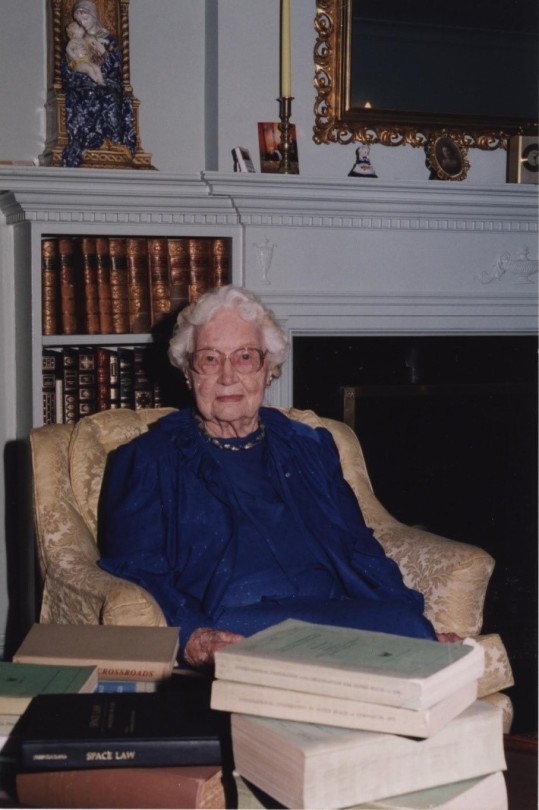4 Little Known Women Who Made Huge Contributions To NASA

LaRue Burbank, mathematician and computer, is just one of the many women who were instrumental to NASA missions.
4 Little Known Women Who Made Huge Contributions to NASA
Women have always played a significant role at NASA and its predecessor NACA, although for much of the agency’s history, they received neither the praise nor recognition that their contributions deserved. To celebrate Women’s History Month – and properly highlight some of the little-known women-led accomplishments of NASA’s early history – our archivists gathered the stories of four women whose work was critical to NASA’s success and paved the way for future generations.
LaRue Burbank: One of the Women Who Helped Land a Man on the Moon
LaRue Burbank was a trailblazing mathematician at NASA. Hired in 1954 at Langley Memorial Aeronautical Laboratory (now NASA’s Langley Research Center), she, like many other young women at NACA, the predecessor to NASA, had a bachelor's degree in mathematics. But unlike most, she also had a physics degree. For the next four years, she worked as a "human computer," conducting complex data analyses for engineers using calculators, slide rules, and other instruments. After NASA's founding, she continued this vital work for Project Mercury.
In 1962, she transferred to the newly established Manned Spacecraft Center (now NASA’s Johnson Space Center) in Houston, becoming one of the few female professionals and managers there. Her expertise in electronics engineering led her to develop critical display systems used by flight controllers in Mission Control to monitor spacecraft during missions. Her work on the Apollo missions was vital to achieving President Kennedy's goal of landing a man on the Moon.
Eilene Galloway: How NASA became… NASA

Eilene Galloway wasn't a NASA employee, but she played a huge role in its very creation. In 1957, after the Soviet Union launched Sputnik, Senator Richard Russell Jr. called on Galloway, an expert on the Atomic Energy Act, to write a report on the U.S. response to the space race. Initially, legislators aimed to essentially re-write the Atomic Energy Act to handle the U.S. space goals. However, Galloway argued that the existing military framework wouldn't suffice – a new agency was needed to oversee both military and civilian aspects of space exploration. This included not just defense, but also meteorology, communications, and international cooperation.
Her work on the National Aeronautics and Space Act ensured NASA had the power to accomplish all these goals, without limitations from the Department of Defense or restrictions on international agreements. Galloway is even to thank for the name "National Aeronautics and Space Administration", as initially NASA was to be called “National Aeronautics and Space Agency” which was deemed to not carry enough weight and status for the wide-ranging role that NASA was to fill.
Barbara Scott: The “Star Trek Nerd” Who Led Our Understanding of the Stars

A self-described "Star Trek nerd," Barbara Scott's passion for space wasn't steered toward engineering by her guidance counselor. But that didn't stop her! Fueled by her love of math and computer science, she landed at Goddard Spaceflight Center in 1977. One of the first women working on flight software, Barbara's coding skills became instrumental on missions like the International Ultraviolet Explorer (IUE) and the Thermal Canister Experiment on the Space Shuttle's STS-3. For the final decade of her impressive career, Scott managed the flight software for the iconic Hubble Space Telescope, a testament to her dedication to space exploration.
Dr. Claire Parkinson: An Early Pioneer in Climate Science Whose Work is Still Saving Lives

Dr. Claire Parkinson's love of math blossomed into a passion for climate science. Inspired by the Moon landing, and the fight for civil rights, she pursued a graduate degree in climatology. In 1978, her talents landed her at Goddard, where she continued her research on sea ice modeling. But Parkinson's impact goes beyond theory. She began analyzing satellite data, leading to a groundbreaking discovery: a decline in Arctic sea ice coverage between 1973 and 1987. This critical finding caught the attention of Senator Al Gore, highlighting the urgency of climate change.
Parkinson's leadership extended beyond research. As Project Scientist for the Aqua satellite, she championed making its data freely available. This real-time information has benefitted countless projects, from wildfire management to weather forecasting, even aiding in monitoring the COVID-19 pandemic. Parkinson's dedication to understanding sea ice patterns and the impact of climate change continues to be a valuable resource for our planet.
Make sure to follow us on Tumblr for your regular dose of space!
More Posts from Cedezsstuff and Others

Milky Way Over Easter Island

Astronomers have discovered a new planetary oddball beyond the solar system that is as fluffy and light as cotton candy. The extrasolar planet or "exoplanet" named WASP-193 b is around 1.5 times the width of Jupiter but has just over a tenth of the solar system gas giant's mass. This makes it the second-lightest planet in the exoplanet catalog, which contains over 5,400 entries. Only the Neptune-like world, Kepler 51 d, is lighter than WASP-193 b. Located around 1,200 light-years from Earth, WASP-193 b orbits its star at a distance of around 6.3 million miles, which is about 0.07 times the distance between Earth and the sun. That means it completes an orbit of its sun-like star, WASP-193, in just 6.2 Earth days.
Continue Reading.

Astronomers have discovered the slowest spinning radio wave-blasting neutron star ever seen; it takes almost an hour to complete a full rotation. That may sound rather fast, but these dead stars are known to spin so rapidly that some experience 700 full turns every second. Even the most leisurely of the about 3,000 radio-emitting neutron stars, or "pulsars," discovered so far complete a full rotation in a second or so. This ultra-leisurely neutron star, however, designated ASKAP J1935+2148 and located 16,000 light-years from Earth, is emitting radio light at a rate too slow to even fit with current theories describing the behavior of these dense stellar remnants.
Continue Reading.

Nora AlMatrooshi
Nora AlMatrooshi, the first Emirati woman astronaut, worked as a piping engineer before becoming an astronaut candidate for the United Arab Emirates. https://mbrsc.ae/team/nora/
Make sure to follow us on Tumblr for your regular dose of space!

On Monday, April 8, 2024, there’ll be a total solar eclipse – and it’ll be the last one to cross North America for 20 years. Make sure you’re tuned in to our live broadcast for this exciting event: there’ll be views from along the path of totality, special guests, and plenty of science.
Make sure to follow us on Tumblr for your regular dose of space!

Storm cloud over Texas l Laura Rowe NASA APOD

When three massive objects meet in space, they influence each other through gravity in ways that evolve unpredictably. In a word: Chaos. That is the conventional understanding. Now, a researcher from the University of Copenhagen has discovered that such encounters often avoid chaos and instead follow regular patterns, where one of the objects is quickly expelled from the system. This new insight may prove vital for our understanding of gravitational waves and many other aspects of the universe.
Continue Reading.

Solar Eclipse

Engineer Karen Leadlay in a General Dynamics computer lab, 1964.

Hey, so--we cooled your boyfriend down to a hundredth of a kelvin above absolute zero. Yeah, it was so cold that all of the chemical reactions in his body ceased. Sorry. We, uh, yeah, we used him as a dielectric material in a tiny qubit. And then we quantum-entangled him with another qubit, just to see if we could. Sorry. Yeah, anyway, we thawed him out after two weeks and apparently he's doing fine now. Didn't really teach us anything about how quantum processes work in biological systems, but it sure was, uh, cool. If you'll pardon the pun.
-
 dr-lapdance reblogged this · 1 month ago
dr-lapdance reblogged this · 1 month ago -
 marooned-in-reality liked this · 2 months ago
marooned-in-reality liked this · 2 months ago -
 sntientcomputer liked this · 2 months ago
sntientcomputer liked this · 2 months ago -
 dirtypigeon19 liked this · 2 months ago
dirtypigeon19 liked this · 2 months ago -
 helianthusaster reblogged this · 2 months ago
helianthusaster reblogged this · 2 months ago -
 helianthusaster liked this · 2 months ago
helianthusaster liked this · 2 months ago -
 nat-tea-n-coffee reblogged this · 2 months ago
nat-tea-n-coffee reblogged this · 2 months ago -
 nat-tea-n-coffee liked this · 2 months ago
nat-tea-n-coffee liked this · 2 months ago -
 solarpunkbaby reblogged this · 2 months ago
solarpunkbaby reblogged this · 2 months ago -
 bi-bee159 liked this · 2 months ago
bi-bee159 liked this · 2 months ago -
 digital0ak liked this · 2 months ago
digital0ak liked this · 2 months ago -
 rosethevoid liked this · 2 months ago
rosethevoid liked this · 2 months ago -
 tristinaautumn liked this · 2 months ago
tristinaautumn liked this · 2 months ago -
 andy202405 liked this · 3 months ago
andy202405 liked this · 3 months ago -
 optimisticc-heartss liked this · 3 months ago
optimisticc-heartss liked this · 3 months ago -
 butter-is-bored liked this · 3 months ago
butter-is-bored liked this · 3 months ago -
 sizzlingcandyjellyfishhhhhh liked this · 3 months ago
sizzlingcandyjellyfishhhhhh liked this · 3 months ago -
 radio-silence-fan reblogged this · 3 months ago
radio-silence-fan reblogged this · 3 months ago -
 radio-silence-fan liked this · 3 months ago
radio-silence-fan liked this · 3 months ago -
 starpilled liked this · 3 months ago
starpilled liked this · 3 months ago -
 sowearecleariamhere liked this · 3 months ago
sowearecleariamhere liked this · 3 months ago -
 absolutesciencefiction reblogged this · 3 months ago
absolutesciencefiction reblogged this · 3 months ago -
 buf309 liked this · 3 months ago
buf309 liked this · 3 months ago -
 mariaisabel992 liked this · 3 months ago
mariaisabel992 liked this · 3 months ago -
 androidsghost liked this · 3 months ago
androidsghost liked this · 3 months ago -
 solarpunkbaby liked this · 3 months ago
solarpunkbaby liked this · 3 months ago -
 empyreanangel reblogged this · 3 months ago
empyreanangel reblogged this · 3 months ago -
 kimberlyn64 liked this · 3 months ago
kimberlyn64 liked this · 3 months ago -
 cabbagesoupenjoyer liked this · 3 months ago
cabbagesoupenjoyer liked this · 3 months ago -
 il0veu liked this · 3 months ago
il0veu liked this · 3 months ago -
 thegirlplug liked this · 4 months ago
thegirlplug liked this · 4 months ago -
 astridvo liked this · 4 months ago
astridvo liked this · 4 months ago -
 carpediemduude liked this · 4 months ago
carpediemduude liked this · 4 months ago -
 imaginesbymonika liked this · 4 months ago
imaginesbymonika liked this · 4 months ago -
 call-me-ryro liked this · 4 months ago
call-me-ryro liked this · 4 months ago -
 dimensionwarp liked this · 4 months ago
dimensionwarp liked this · 4 months ago -
 celestialveilinn reblogged this · 4 months ago
celestialveilinn reblogged this · 4 months ago -
 datafag1 liked this · 4 months ago
datafag1 liked this · 4 months ago -
 emmielemie reblogged this · 4 months ago
emmielemie reblogged this · 4 months ago -
 destinopino liked this · 5 months ago
destinopino liked this · 5 months ago -
 wheresmyeddiemunson liked this · 5 months ago
wheresmyeddiemunson liked this · 5 months ago -
 halaagmod liked this · 5 months ago
halaagmod liked this · 5 months ago -
 bookbansheee liked this · 5 months ago
bookbansheee liked this · 5 months ago -
 marecrisis liked this · 5 months ago
marecrisis liked this · 5 months ago -
 calliope-ev liked this · 5 months ago
calliope-ev liked this · 5 months ago
